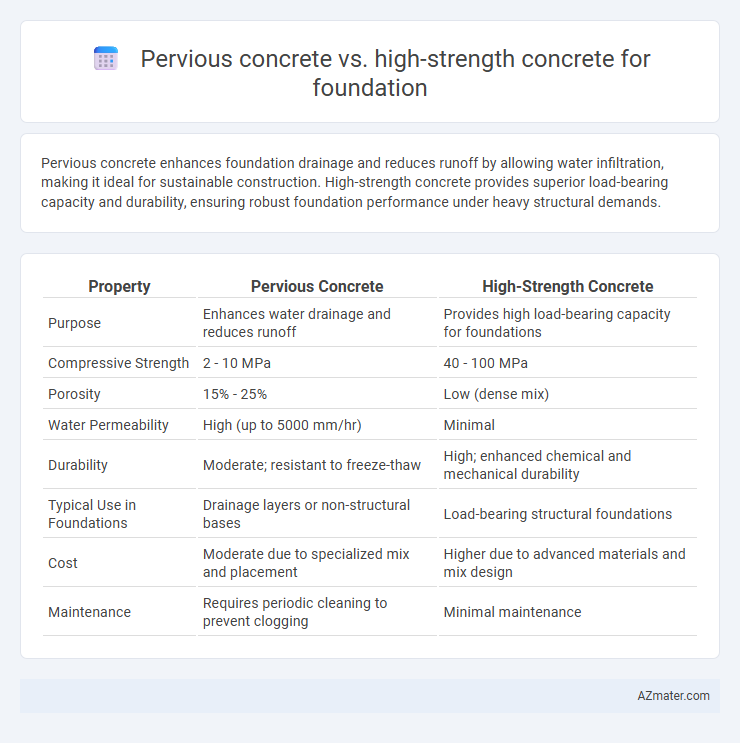Pervious concrete enhances foundation drainage and reduces runoff by allowing water infiltration, making it ideal for sustainable construction. High-strength concrete provides superior load-bearing capacity and durability, ensuring robust foundation performance under heavy structural demands.
Table of Comparison
| Property | Pervious Concrete | High-Strength Concrete |
|---|---|---|
| Purpose | Enhances water drainage and reduces runoff | Provides high load-bearing capacity for foundations |
| Compressive Strength | 2 - 10 MPa | 40 - 100 MPa |
| Porosity | 15% - 25% | Low (dense mix) |
| Water Permeability | High (up to 5000 mm/hr) | Minimal |
| Durability | Moderate; resistant to freeze-thaw | High; enhanced chemical and mechanical durability |
| Typical Use in Foundations | Drainage layers or non-structural bases | Load-bearing structural foundations |
| Cost | Moderate due to specialized mix and placement | Higher due to advanced materials and mix design |
| Maintenance | Requires periodic cleaning to prevent clogging | Minimal maintenance |
Introduction to Pervious and High-Strength Concrete
Pervious concrete is a porous material designed to allow water to pass through, reducing runoff and promoting groundwater recharge, making it ideal for sustainable foundation applications. High-strength concrete offers superior compressive strength, typically exceeding 6000 psi, ensuring durability and support for heavy structural loads in foundation construction. Selecting between pervious and high-strength concrete depends on site drainage requirements and load-bearing capacity needs.
Key Properties of Pervious Concrete
Pervious concrete features high porosity, allowing water to permeate through its interconnected voids, which reduces stormwater runoff and improves groundwater recharge. Its compressive strength typically ranges between 2.5 to 28 MPa, making it suitable for light to moderate load-bearing applications but generally lower than traditional high-strength concrete, which often exceeds 40 MPa. The permeability and durability of pervious concrete depend heavily on aggregate size, compaction method, and porosity, distinguishing it from high-strength concrete's dense, low-permeability matrix optimized for maximum load capacity.
Core Characteristics of High-Strength Concrete
High-strength concrete, characterized by a compressive strength exceeding 6,000 psi, offers superior durability and load-bearing capacity compared to pervious concrete, making it ideal for foundation applications requiring structural integrity. Its dense microstructure enhances resistance to environmental factors, reducing permeability and increasing lifespan. Unlike pervious concrete, which prioritizes water drainage through high porosity, high-strength concrete ensures maximum strength and stability for foundational support.
Durability and Longevity Comparison
Pervious concrete offers superior permeability, allowing water drainage that reduces hydrostatic pressure and mitigates freeze-thaw damage, enhancing durability in foundations exposed to moisture. High-strength concrete, with compressive strengths often exceeding 6,000 psi, provides exceptional load-bearing capacity and resistance to cracking, promoting long-term structural integrity. While pervious concrete excels in mitigating water-related deterioration, high-strength concrete ensures longer service life under heavy loads and aggressive environmental conditions.
Load-Bearing Capacity: Which Performs Better?
Pervious concrete offers excellent drainage but generally has a lower load-bearing capacity compared to high-strength concrete, making it less suitable for heavy foundation loads. High-strength concrete, with compressive strengths often exceeding 6000 psi (41 MPa), provides superior structural support and durability in load-bearing applications. For foundation projects demanding maximum load capacity and long-term stability, high-strength concrete outperforms pervious concrete significantly.
Water Management and Drainage Capabilities
Pervious concrete enhances water management by allowing water to permeate through its porous structure, effectively reducing runoff and promoting natural groundwater recharge in foundation applications. High-strength concrete, while offering superior load-bearing capacity and durability, typically has low permeability, which limits its drainage capabilities and can lead to water accumulation issues around foundations. Combining pervious concrete in drainage layers with high-strength concrete for structural elements optimizes both foundation stability and efficient water management.
Environmental Impact and Sustainability
Pervious concrete significantly enhances environmental sustainability by allowing water infiltration, reducing runoff, and recharging groundwater, which mitigates urban flooding and supports natural water cycles. High-strength concrete, while offering superior load-bearing capacity and durability for foundations, often requires higher cement content, leading to increased carbon emissions during production. Choosing pervious concrete promotes eco-friendly construction by balancing structural needs with reduced environmental footprints, making it ideal for sustainable foundation projects.
Cost Analysis and Economic Considerations
Pervious concrete typically offers lower initial material costs but may require more frequent maintenance due to its porous nature, impacting long-term expenses for foundation applications. High-strength concrete, while more expensive upfront, provides superior durability and load-bearing capacity, potentially reducing repair and replacement costs over time. Economic considerations should balance initial investment against lifecycle performance, site drainage requirements, and local environmental regulations influencing overall project cost-efficiency.
Suitability for Different Foundation Types
Pervious concrete is ideal for foundations requiring enhanced drainage and groundwater recharge, such as slab-on-grade and shallow foundations in areas prone to water accumulation, due to its high permeability. High-strength concrete suits deep foundations like piles and caissons, providing superior load-bearing capacity and durability in heavy structural applications and challenging soil conditions. Choosing between pervious and high-strength concrete depends on site drainage needs, load requirements, and foundation depth, ensuring optimal performance for specific structural demands.
Best Practices for Selecting Concrete for Foundations
Pervious concrete improves foundation drainage and reduces hydrostatic pressure, making it ideal for projects requiring superior water management and environmental sustainability. High-strength concrete offers enhanced load-bearing capacity and durability, recommended for foundations subject to heavy structural loads or aggressive environmental conditions. Selecting the optimal concrete involves evaluating site drainage requirements, load specifications, and long-term performance goals to ensure foundation stability and longevity.

Infographic: Pervious concrete vs High-strength concrete for Foundation
 azmater.com
azmater.com